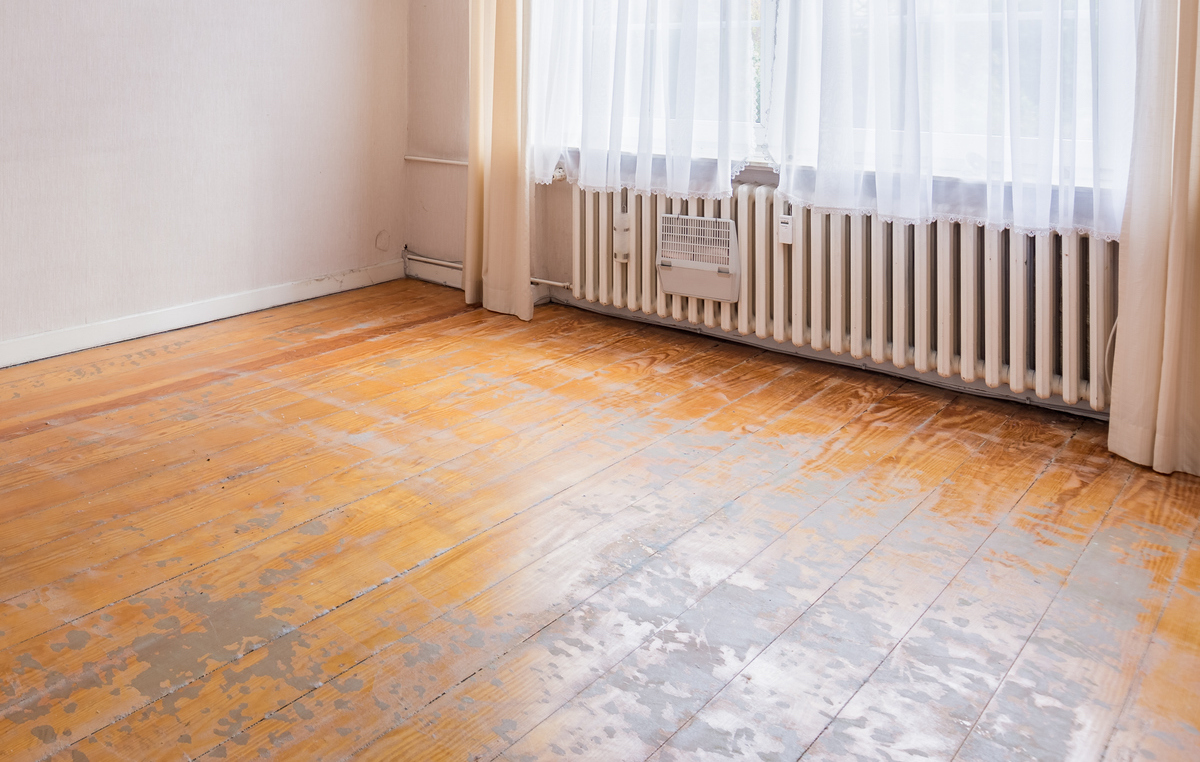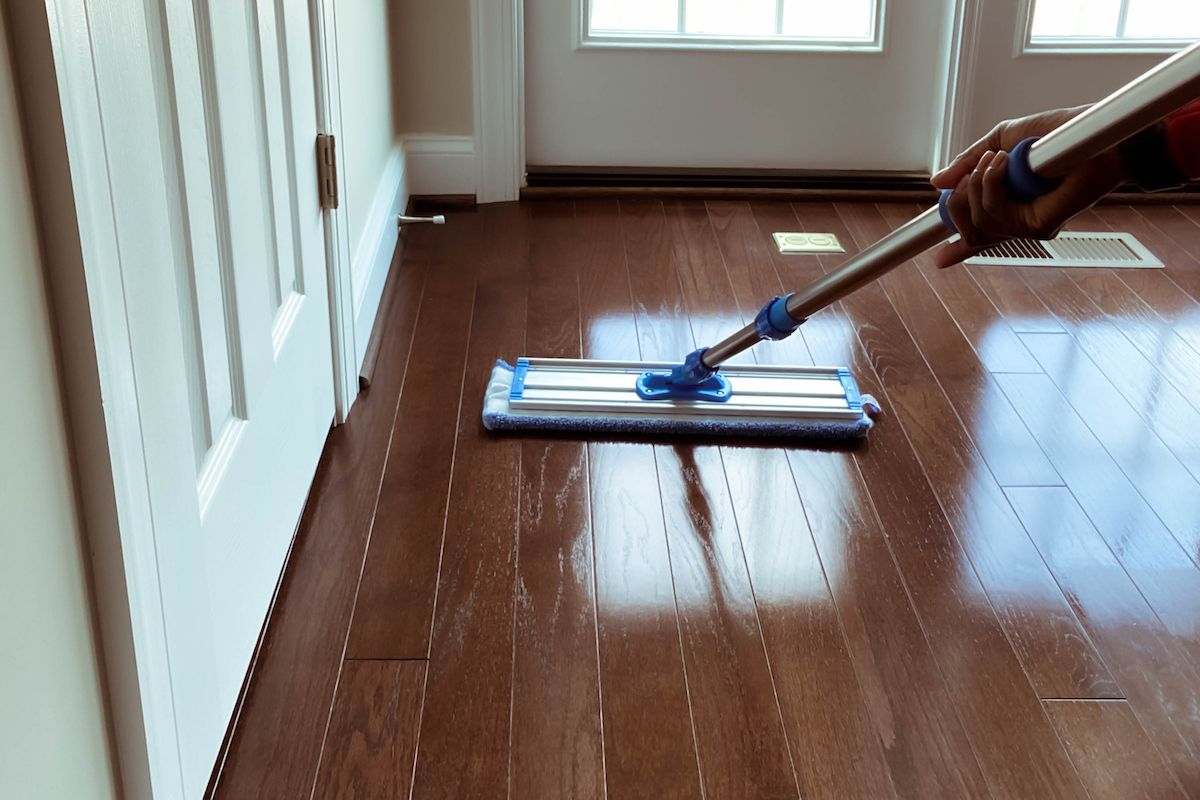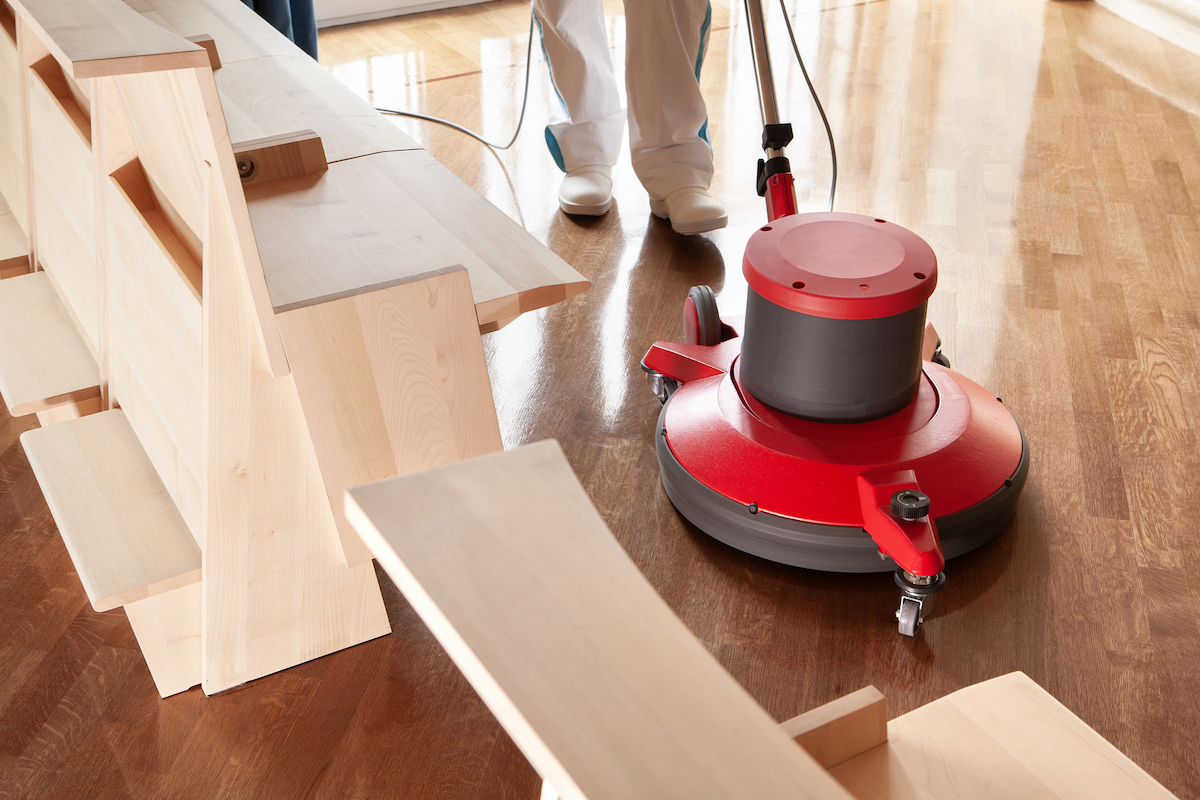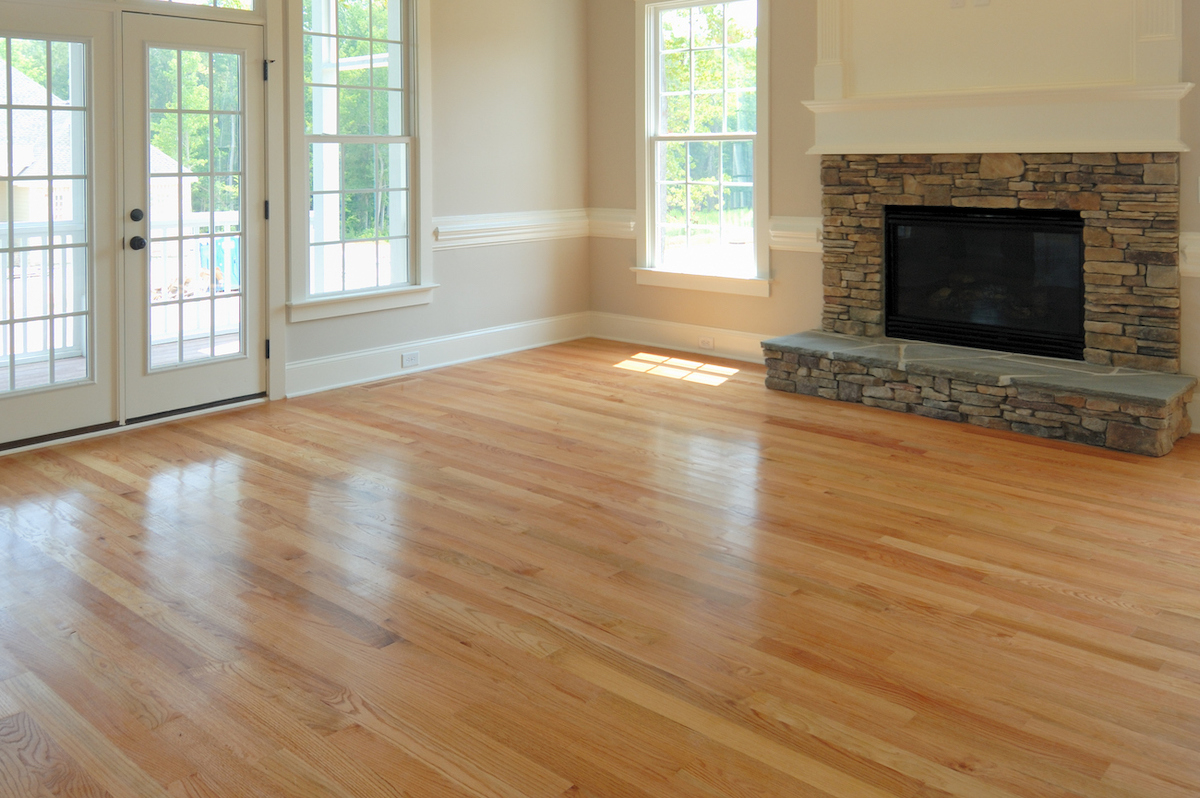We may earn revenue from the products available on this page and participate in affiliate programs. Learn More ›
Hardwood floors add classic elegance to your home, but not when they’re dull, dinted, or dingy. Fortunately, waxing hardwood floors is an economical, tried-and-true way to restore their gleam and prolong their life. Ahead, we explain technique for applying a high-performing wax finish that will look so grand, you’ll be walking on air!
Why wax hardwood floors?

Popularized in the 1940s, waxing is a floor-finishing technique in which clear or colored wax, made of a blend of solvents and synthetic and/or natural waxes like beeswax or carnauba, is applied to a hardwood floor in a thin layer and then buffed to a shine. It is different from floor polishing, which forms a hard, transparent coating. As the solvents in floor wax evaporate, the wax hardens into a protective seal that confers a host of benefits:
- Increases stain resistance: The wax seal limits the absorption of spills to keep floors from staining.
- Minimizes minor imperfections: Wax fades or eliminates the appearance of superficial scratches, dings, and scuffs marks.
- Preserves underlying finishes: Wax acts as the first line of defense against spills, dust, and dirt, preventing them from encroaching on underlying hardwood floor finishes, such as oil, and enabling the underlying finish to last longer.
- Prolongs floor life: The increased hardiness of waxed floors allows them to potentially last years longer than unwaxed floors if regularly maintained.
- Boosts beauty: Clear wax lends a shiny look and a glossier feel that vacuuming or mopping alone can’t achieve. Colored waxes, available in hues on the brown spectrum, offer these same benefits plus an attractive tint that gives floors an even richer, deeper patina.
That said, wax offers only limited resistance to deeper dents or gouges, and does little to ward off warping or bulging from widespread moisture exposure due to leaks or minor floods. Wax should be considered as a top coat—a final layer of protection, not the only protective finish, on a hardwood floor.
Is wax good on all floors?
The best candidate for waxing is a hardwood floor that was previously treated with a penetrating wood sealer, lacquer, varnish, shellac, or oil. Wax can bolster the protective properties of these finishes. However, you can also wax unfinished floors.

Pro Tip
Never wax urethane-finished floors. Waxing them could prevent them from being effectively recoated with urethane—instead, use polish.
It should go without saying, but you’ll also want to avoid flooring that’s labeled “no-wax,” including no-wax linoleum or vinyl flooring that looks like wood. These types of flooring come with a factory coating that doesn’t require waxing.
Waxing is also only suitable for hardwood floors in good structural condition; that is, with no significant chipping, gouging, discoloration, warping, or bulging. If your hardwood is plagued with these problems, replace or repair affected floorboards (e.g., sand away discoloration or fill gouges with wood filler) before waxing hardwood floors.
Which type of wax should I use?

When shopping for quality hardwood floor wax, there are a few phrases that you want to look for on the product’s label. We’ve found that the best waxes for floors have these characteristics.
- Solid paste wax or liquid wax: Solid paste wax, sold in cans usually contains more wax and less solvent (Minwax finishing wax is about $17 for 16 ounces). This kind of wax has a thick consistency that must be applied by hand with a cloth, but requires fewer coats than liquid wax. Liquid wax is available in cans or bottles (a quart of Rust-Oleum Satin Wax for Finishing is about $23) contains more solvent, so has a thinner consistency and can be applied by mop, but requires multiple coats.
- Labeled for use on floors: Steer clear of waxes labeled exclusively for use on furniture, as they harden into an ultra-slick coat that makes floors slippery.
- Solvent-based, not water based. Avoid water-based or acrylic waxes on hardwood floors; they can cause finished floors to take on a white tinge and can damage unfinished hardwood floors.
- It’s buffable. Look for traditional waxes that must be buffed after application; eschew one-step (i.e., “no-buff”) waxes, as dirt readily clings to them.
How to Wax Hardwood Floors

There are three phases of waxing hardwood floors: surface preparation, application, and buffing. Here’s how to complete each phase quickly and effectively.
How to Prepare a Floor for Wax
- Remove rugs and furniture from the room.
- Strip old wax, if there is any, by working a soft cloth dampened with mineral spirits or a commercial wax stripper such as Trewax Heavy Duty Floor Stripper over 2-foot sections of the floor at a time. Continue until no more wax residue comes off on the cloth. Slough off stubborn wax build-up with fine-grade steel wool.
- Dry-mop (with a microfiber cloth pad) or vacuum the floor with a dust brush attachment to eliminate dust and any loose wax build-up.
- If the floor is still dingy after dusting, use a sponge mop to remove grime. Work in 3-foot sections at a time, using a store-bought hardwood floor cleaner, like Bona Hardwood Floor Cleaner, or a homemade equivalent consisting of ¼ cup of dish soap and 1 gallon of warm water. Damp mop the hardwood floor with water to remove leftover cleaner, then dry it with a clean towel.
How to Apply Hardwood Floor Wax
- Wear gloves and a dust mask to protect yourself from fumes in wax solvents.
- Get into a comfortable kneeling position before applying solid paste wax, as it should be applied by hand (knee pads ought to help). If you are applying liquid wax, remain standing.
- Grab a putty knife and a soft, lint-free cloth if applying solid wax. For liquid wax, enlist a sponge mop for the quickest application.
- Scoop 1 tablespoon of solid wax with the putty knife onto a soft, lint-free cloth. If using liquid wax, pour or squeeze 1 tablespoon from the can or bottle directly onto the hardwood floor, then dip the mop head into the wax.
- Working in 1- to 2-foot sections, spread a thin layer of solid wax with the cloth, or liquid wax with a sponge mop. Start at one corner of the room and move towards an exit, waxing hardwood floors in the direction of the floorboards. When you’ve used up your first batch of wax, apply more to the cloth or to the floor until you’ve covered the entire room.
- Let the first coat dry. This can take anywhere from 10 minutes to an hour, depending on the product.
- Apply additional coats per the manufacturer’s recommendation, allowing each to dry in between. Solid paste wax generally hardens into a thicker layer of protection, so one coat is often sufficient over finished wood, or two coats over unfinished wood, whereas liquid wax usually needs two to three coats at a minimum, as each coat is much thinner.
- Let the final coat of wax dry just until hazy; at this point, it’s ready to buff.
How to Buff Waxed Wood Floors
- Using a towel for solid wax or a sponge mop with a terry cloth head for liquid wax, rub the cloth, or glide the mop over 2-foot sections of the floor at a time. Start in the same corner of the room where you began and move in the direction of the wood grain, buffing to the desired luster.
- Employ an electric floor buffer/polisher (these can be rented from The Home Depot by the half day) to speed up the process of buffing. These machines can be used on either solid or liquid wax.
- Leave the freshly waxed floor undisturbed for at least 8 hours before stepping on it or replacing furniture.
How to Maintain Waxed Hardwood Floors

Follow these tips to prolong the life and luster of your waxed hardwood floors:
- Re-wax floors occasionally: Check the label on your wood floor wax, and rewax at the interval recommended by the manufacturer. Generally, solid wax coats can last 2 to 5 years, and liquid wax coats 1 to 2 years. If no re-waxing interval is given, wipe a cloth dampened with mineral spirits over a small section of your floor and inspect it. If the cloth is clean with no whitish or colored residue, no wax remains. It’s time to re-wax.
- Avoid wax buildup: Don’t apply fresh wax before the old wax coat has worn off, as over-waxing hardwood floors can result in unsightly wax build-up.
- Buff out imperfections: In between waxings, fade superficial imperfections by buffing floors using the tips above.
- Keep floors clean: Weekly dry-mop waxed floors with a microfiber cloth pad, or vacuum with a dust brush attachment, to keep dust at bay.
- Be judicious with the mop: Avoid wet-mopping large areas of the waxed hardwood floor with water; it can cloud the wax coat or damage the wood. Mop hardwood floors in small sections at a time, and dry each section immediately.
- Keep floor dry: Wipe up spills as soon as they occur with a water-dampened cloth, then wipe dry.
- Use a special cleaner: Remove stains or discoloration by working hardwood floor cleaner into the offending spot with a cloth. Use a water-dampened cloth to remove the leftover cleaner, then dry with a clean towel.
- Keep dirt out: Lay rugs or mats at the foot of doorways near waxed hardwood floors to keep dirt from being tracked in.
- Move furniture carefully: Lift, rather than drag, furniture across the waxed hardwood floors to avoid dents.

